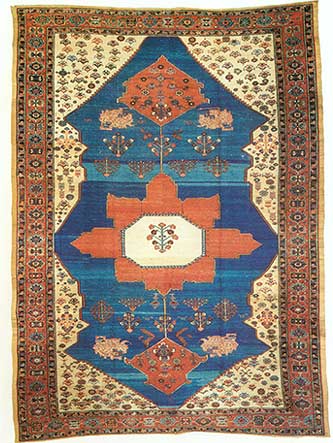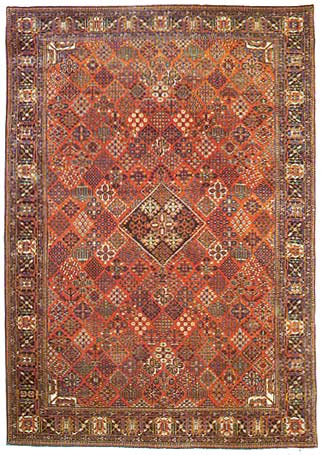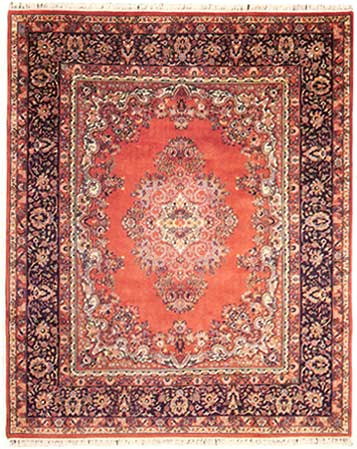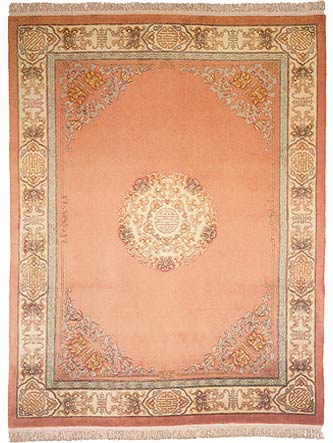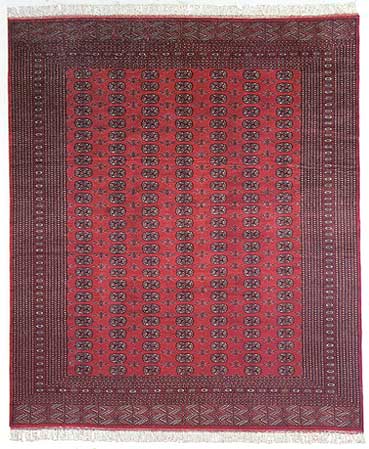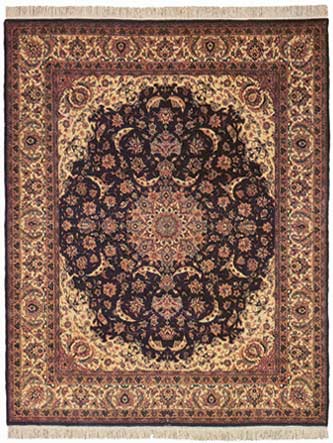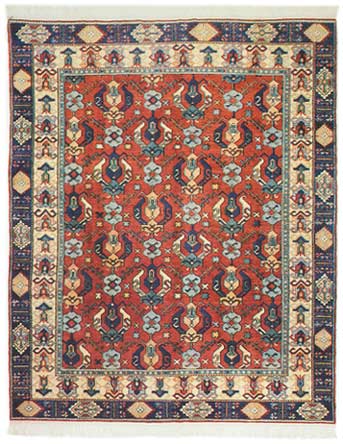RUG GUIDE
Rug Introduction 
The Illustrated Rug 
From Sheep To Rug 
Rug & Knot Types 
Rug Loom Types 
Basic Rug Care 
Stain Removal Guide 
Decorating Ideas 
Purchasing Guide 
Rug Names & Places 
Rug History Chart 
Glossary of Terms 
Presented by NEJAD RUGS:
THE ILLUSTRATED RUGIRAN (Persia) Known as the original home of the Oriental carpet, Iran (Persia) the oldest and once the most powerful empire in the Middle East, stood at the crossroads of Eastern and Western civilizations. Under the Safavid dynasty (1502-1736), Iran attained its artistic height, and court weaving, together with the art of calligraphy, miniature painting, and tilework, flourished to exceptional heights. This brilliant era witnessed the development of highly qualified carpet factories in cities including Kerman, Isfahan, Kashan, Tabriz, and Herat (now a part of Afghanistan). Iran is the genesis of most motifs, patterns, and traditional colorations produced in rugs throughout the world today. Over the centuries, Persian carpets have become treasured heirlooms passed on from one generation to the next. By the mid-19th century, American, British, and German firms had established new carpet production facilities in Meshed, Tabriz, Kerman, and Sultanabad (now Arak), thus ensuring the art form's continued development. And in the 20th century, under Shah Reza Pahlavi, royal factories were established to utilize only the finest materials and methods of manufacture. Oriental rugs have always been and are still an intrinsic part of Iranian culture and its people's daily lives. Indeed, Oriental rugs are in many cases their most valued possession and are an integral part of their home furnishings. Thus, it is not surprising that current production levels throughout Iran equal if not surpass those reached prior to the Islamic Revolution of 1979. In fact, rugs are now even produced in areas where weaving was heretofore not practiced. Furthermore, Persian carpets continue to boast very high quality standards and command a very brisk interest in domestic and international markets. While large city workshops were an important factor in the past, much of today's production is fashioned along cottage industry lines in smaller villages and towns.
Persian carpets are traditionally known for their tremendous variety in design, color, size, and weave, and for the uniqueness of each and every rug produced. Rugs are generally named after the village, town, or district where they are woven or collected, or by the weaving tribe in the case of nomadic pieces. Each rug's particular pattern, palette, and weave are uniquely linked with the indigenous culture, and weaving techniques are specific to an identifiable geographic area or nomadic tribe. Such is the case, for instance, of the richly colored Bakhtiari rugs frequently characterized by ellipse-shaped medallions with floral patternswoven by the Bakhtiari nomads and villagers of southern Iran. Generally smaller in size, Persian nomadic, village, and flat-woven rugs (e.g., kilims) are broadly characterized by traditional angular designs and bold as well as somber colors. Typical is the south Persian Qashqai, often finely woven and featuring a diamond-shaped medallion on a detailed background of geometric or stylized flowers. Predominant colors include reddish browns and blues. Other nomadic and village types include the Bakhtiari, Ramadan, Shiraz, Kurd, and Karaja. Meanwhile, the more sophisticated carpets originating from the historic cities of Tabriz, Kashan, Kerman, Nain, and Qum feature finely woven floral patterns and complex curvilinear motifs. More elaborate pieces are often pictorial in design and depict hunting scenes, men in combat, landscapes, and historic folklore figures. Persian carpets offer a full gamut of colorations from the pastel shades of champagne, rose, and green, typical of a Kerman for instance, to the striking reds and blues of a Heriz. This highly popular pattern is characterized by a bold and angular medallion and corner design. Just as with design, Persian color ways are a continued source of inspiration for other rug-producing countries throughout the world.
INDIA Carpet weaving was introduced to India during the 16th century following the Mogul conquest of Akbar the Great. Influenced by Persian culture, this Moslem dynasty established carpet factories which produced Persian-inspired weavings as well as classic Mogul carpets featuring realistic floral and pictorial renditions. For centuries, India created among the most exquisite carpets in history, mainly in Jaipur, Kashmir, Agra, and Benares. Today, many of them are guarded museum masterpieces. With the decline of the Mogul empire and the corresponding rise of the British empire during the 19th century, the international carpet trade developed an increasing interest in India. The years succeeding World War I witnessed a significant growth in exports to the United States, initially of coarser-quality rugs featuring the French Aubusson pattern (a formal floral design) and Chinese-inspired motifs. Beginning in the 1970s the Indian rug industry, responding to an international demand for Persian-design rugs, returned to its historic Persian weaving tradition by developing and producing increasingly finer qualities of rugs. Today, the Indian weaver not only creates works which rival their Persian counterparts but which also reveal a creative ingenuity of their own. At present, India is one of the primary sources for both pile and flat-woven rugs available in an impressive range of qualities, designs, colorations, and sizes. Indeed, Indian weavers have demonstrated a remarkable ability to adapt to ever-changing Western decorative tastes while recreating Persian rug designs at increasingly higher quality standards. As in the past, Indian weaving production is currently organized on a cottage industry basis, and the vast majority of pile rugs and flat weaves are crafted in villages throughout the Mirzapur/Bhadohi region while smaller centers are located in Jaipur, Gwalior, Kashmir, Agra, and Amritsar. Aubusson-patterned rugs are now a minor factor in the export market, as Persian-design carpets constitute the predominant category of Indian pile rugs woven today. Thanks to the weavers' expert understanding and execution of design, coloration, and knot density, these rugs are often considered to best approximate the look, texture, and feel of their Iranian-made counterparts. Kashan, Tabriz, Kerman, Sarouk, and Bijar are among the many popular Persian patterns that have inspired faithful recreations and innovative adaptations. The Indian weaver has mastered the rendition of these patterns in traditional Persian-style hues (e.g., dark reds and blues) and in contemporary colorations, including jewel tones and pastels, attuned to the very latest in home furnishings fashion trends. Moreover, their rugs are produced in an impressive range of qualities averaging from approximately 85 to 150 knots per square inch. Some Indian weavers' dexterity is such that they are even able to produce carpets with over 300 knots per square inch. The woolen yarns used are generally blends of Indian and imported New Zealand wool which together provide the carpet with a naturally lustrous appearance. Additionally, a small number of all-silk carpets featuring about 400 knots per square inch continue to be produced in Kashmir.
The expertise of India's weavers extends beyond that of producing pile carpets. Indeed, the country is equally renowned for its production of flat weaves, notably dhurries and chainstitch rugs whose techniques are indigenous to its culture and date back possibly several thousands of years. These handcrafted flat weaves blend in with a variety of contemporary and traditional settings while offering an excellent and affordable purchasing opportunity that may be particularly appealing to the first-time buyer.
Most popular in the last decade have been wool dhurries, now mainly characterized by floral designs in an array of fashionable colorations including pastels and more vibrant hues. Also available, although in lesser quantity, are cotton dhurries displaying bold geometric patterns. Chainstitch or crewel-embroidered rugs chiefly produced in and traditionally indigenous to Kashmir have recently experienced a tremendous resurgence in popularity thanks to their exquisitely detailed floral patterns, often European-inspired, executed in a full range of contemporary colorations. India is a world leader in Oriental rug exports thanks to its tremendous production capacity and to its weavers' dexterity, versatility, and willingness to constantly experiment with color and design combinations in an attempt to be responsive to American consumer demand. India offers a complete range of pile and flat-woven rugs in a wide range of qualities, styles, colors, and sizes. These handcrafted floor coverings are suitable for a broad spectrum of decorative specifications in residential and commercial settings alike. CHINA Chinese carpets were first woven centuries ago by nomadic tribes in the Sinkiang and Ninghsia regions of western China where they were used for both decorative and functional purposes. In the early to mid-19th century, this simple craft began to flourish on a much larger scale at the Imperial Court of Beijing. Particularly instrumental in developing the art was the patronage of Ch'ien Lung, Chia Ch'ing, and Tao Kuang, three rulers of the Ch'ing Dynasty (1644-1912). During the mid-to-late 19th century, China's entire carpet production was destined for local consumption, being sold commercially to the native noble and upper classes. Western awareness of Chinese weavings increased significantly during the Boxer Rebellion of 1900 when many palaces and residences were looted and the spoils of war were sent abroad. Chinese carpets first won official recognition at the 1903 Saint Louis International Exhibition where an entry was awarded first prize. With Western interest now kindled, substantial efforts were made to transform a cottage handicraft into a major industry in the Beijing/Tianjin area of northeastern China. In the 1920s, so-called Peking- and Tiensin-style rugs were produced according to American importers' specifications and were "all the rage" in the United States. Following President Richard Nixon's memorable trips to China in 1971 and 1972, which resulted in the reestablishment of trade between the United States and China, Chinese carpets reemerged in the United States in 1973. They have since become a major force in the home furnishings market due to their tremendous versatility in type, style, and color, and executed with high quality control standards. Equally important has been the Chinese weavers' expertise and willingness to adapt designs and colorations to American decorative trends. Most carpets are still woven in the northeastern provinces of China with the balance originating from the western and southern regions. Weaving is performed in factories scattered in cities and throughout the countryside. Rug production is essentially made up of autonomous provincial enterprises or cooperatives, each competing for a share of the market. The rugs are warehoused for export in the principal cities or ports of the producing provinces. Notable among the producing cities are Beijing, Tianjin, Qingdao, Shanghai, Dalian, Nanjing, Hangzhou, and Baoding. The factories have from a few to several hundred looms, and the manufacturing process is closely supervised for quality control. While many of the looms are still built of wood, most new ones are built of steel. As they are so well built and stout, whether of wood or steel, crooked pieces are seldom produced. The carpets are woven of excellent quality indigenous wool featuring durable and resilient yarn or with a blend of native and imported wool. Today's consumer has a wealth of patterns and colors to choose from both in pile and flat-woven rugs. The most popular design categories for pile rugs are Peking, floral, esthetic, and Sino-Persian. Peking rugs, stylistically the most indigenous to Chinese culture, generally feature a central medallion on an open or covered field of traditional and often stylized motifs and symbols, such as animals, flowers, clouds, and vases, framed by a simple, wide border. Equally in demand are floral rugs often characterized by an all-over pattern or by asymmetrically placed floral sprays. The popular Art Deco style floral carpets, based on the "Tientsin-style" rugs of the 1920s, generally feature an asymmetrical floral pattern sometimes with objects such as birds and pagodas, and wide solid-colored borders. Esthetic rugs inspired by the floral patterns of French Savonnerie and Aubusson carpets are generally characterized by a large central medallion and an open field with surrounding designs.
Peking, floral, and esthetic rugs' colorations are keyed to the very latest American decorative trends and range from pastels to the more vibrant jewel tones. These three rugs styles usually carved or incised to produce depth and shading are woven in qualities ranging from 70 to 120 lines and averaging 90 lines. This line count system is unique to China, and a 90-line rug, for instance, means that it has 90 knots in one linear foot both across the width and length of the rug and contains approximately 56 knots per square inch (90 knots times 90 knots divided by 144 inches per square foot equals 56 knots per square inch). Undoubtedly, the most talked about category of Chinese carpets woven today is the Sino-Persian. These carpets rival their Persian-design counterparts originating in Iran, India, Rumania, and Pakistan. They are produced in qualities ranging from 120 to 300 lines, with most pieces averaging 200 lines (approximately 278 knots per square inch). Sino-Persian rugs are based on Iran's most celebrated designs, namely Kashan, Lavar Kerman, Sarouk, Tabriz, and Isfahan, and are executed in a broad array of both traditional Persian (e.g., dark reds and blues) and contemporary hues. After receiving hundreds of Persian designs from importers around the world, Chinese designers have now developed the ability to "rework" their vast repertoire of design elements into an infinite number of new designs rivaling Iran itself. A smaller but nonetheless important segment of Chinese pile rug types includes contemporary-design pieces displaying a broad spectrum of free-form patterns and antique-style rugs that are attractive recreations of vintage Peking-style rugs often woven with vegetable-dyed wool. Also available are limited quantities of silk carpets, generally in smaller sizes, containing up to 625 knots per square inch. Virtually unique to China is the production of wool pile rugs in odd shapes. Indeed, rounds, ovals, squares, and hexagons are available in a broad range of styles and colors. They are particularly well suited in defining a room's particular angle.
In the last decade Chinese flat weaves, namely kilims and needlepoints, have made tremendous inroads into the marketplace. Chinese kilims offer an excellent variety of floral and geometric patterns in traditional and fashion-oriented colors and in a wide range of sizes including standard room sizes which are often difficult to find in other types of flat weaves. Needlepoint rugs have recently been reintroduced to the American market and are enjoying the same success they had had during the 1920s and 1930s. Hand-embroidered in wool, these floor coverings exquisitely recreate the look of 18th and 19th century English and French needlepoints in a vast spectrum of colors. Noteworthy as well are tufted carpets (also referred to as full-cuts, gun-tufted, or latex-backed carpets) which haven been produced in China for several decades. Because these carpets are not woven on a warp and weft foundation they do not technically qualify as Oriental rugs. The pile of these carpets is created with a hand-held tufting gun which loops the yarn through a canvas type backing. The back of the loops is then covered with latex to prevent the tufts from being pulled out. The loops on the face are then sheared to create a cut pile very similar to the pile of an Oriental rug, and the back is covered with a cloth to protect the latex foundation. Since the same wool, washing, and carving techniques are used to produce these carpets as used in handknotted carpets, they have a very similar appearance from the face. While these carpets represent excellent value, you should be aware that they are not handwoven Oriental carpets. China offers the consumer one of the broadest varieties of design styles including Chinese, Persian, European, and contemporary to choose from. Equally appealing are the rugs' decoratively attuned colorations as well as the variety of construction types such as pile, kilim, and needlepoint. Having established an enviable reputation in decorative home furnishings, it is no wonder that today China is a leading exporter of Oriental carpets to the United States. PAKISTAN The art of carpet weaving originated in the Indian subcontinent under the reign of Akbar the Great (1542-1605). During that period, Persian weavers were brought to Lahore where several carpet factories were established. In the years that ensued, weaving in this region developed at an impressive pace. Following the partition of India in 1947, Pakistan became a geopolitical entity where Moslem weavers from India, and Turkoman craftsmen from the north, were attracted to the large weaving centers located in and around the cities of Lahore and Karachi. With the help of government subsidies, the carpet industry began to flourish in the 1960s and has since become one of the most significant sources of export revenue for this country.
In contemporary Pakistan, carpet weaving has remained mainly a cottage industry with the great majority of pieces manufactured in individual dwellings which may contain several looms. Today, rugs are woven with high-quality blends of indigenous and imported wool. Approximately 70% of the weaving is done within a 400-mile radius of Lahore, the capital of the Punjab province. Karachi, the capital of the Sind province, represents some 20% of the total output. The areas around the cities of Quetta and Peshawar generate the remaining 10%. Until the 1970s, Pakistan had predominantly woven Bokkaras characterized by a repetitive octagonal or gul motif which is based on a traditional Central Asian Turkoman design. Today Bokkaras still account for a significant portion of total production and are available in two styles, Mori and Jaldar. Mori Bokkaras feature the traditional gul motif and come in a broad array of colors including traditional hues (e.g., reds, rusts, and ivories), pastels, and fashion shades (e.g., peaches, corals, greys). More recent has been the development of Jaldar Bokkaras generally displaying geometric, contemporary-style designs as well as motifs based on nomadic Caucasian sources. Colors are mainly contemporary, including pastels and jewel tones as well as black. Mori Bokkaras are generally woven in qualities of 200 to 242 knots per square inch while Jaldar Bokkaras range from 162 to 200 knots per square inch. Bokkaras come in a full assortment of sizes ranging from one-foot squares to room sizes and runners.
In the last decade, higher-quality Persian-design carpets featuring colorations attuned to American fashion have become the predominant type of Oriental carpets available in Pakistan. Here, the weavers possess an almost intuitive sense in executing the designs of their Iranian neighbors thanks to their historical association with Persian weaving techniques and to their Islamic cultural and religious background. By far, the most readily available quality of Pakistani Persian-design carpets today is the so-called 16/18 which is roughly equivalent to 288 knots per square inch. Pakistani 16/18 weavers generally concentrate on reproducing the more intricate Persian patterns namely Kashan, Tabriz, Nain, and Isfahan which require a greater number of knots. These designs are colored to suit all tastes including the traditional Persian reds and navies, in addition to pastels and the very latest designer hues. It's not unusual for these fine carpets to contain as many as 20 different colors. In addition, the 16/18s' low pile height enhances the crispness of the designs and their tight' 'handle" or feel approximates that of their Persian counterparts. Persian-design carpets are also found in other qualities ranging from about 195 to 324 knots per square inch, but the latter knot count quality only exists in smaller-sized rugs of 4x6 and below. Pakistan deserves careful consideration as its very strong production capacity is geared to specific American decorative requirements. The broad range in colors and patterns, as well as the availability of higher-end Persian-style carpets, provides ample choices for today's consumer. TURKEY Until Persian rugs were exported in the 17th century, Turkish weavings were the only Oriental floor coverings known to Europe and thus the terms "Turkey carpets" and "Oriental carpets" were virtually interchangeable. Turkey's rug-weaving industry dates back to the llth century and was developed successively by the Seljuk (llth - 13th centuries) and Ottoman (c. 1300 -1922) dynasties and by the modem Turkish republic. The Oriental rugs currently being produced in Turkey have the historic character of their antique counterparts in patterns and colors geared to today's decorative tastes. As in Iran, rug weaving in Turkey is an intrinsic part of its culture and is practiced in villages throughout the country. A substantial portion of the production is destined for domestic and local tourist consumption rather than for export. Thus, much of the demand for these weavings including pile rugs and flat weaves, saddle and grain bags, and silk pieces comes from collectors and consumers looking for something that is both different and distinctive. Indeed, it is often said that Turkey's appeal emanates from its carpets' tribal, primitive character. Of special interest today is the renaissance of traditional weaving techniques, namely that of using vegetable dyes and handspun wool (produced from both domestic and imported wool) in areas around Izmir, Canakkale, Konya, Kayseri, Oushak, Hercke, Diyarbakir, Malatya, Kars, and Erzurum. Originally initiated in 1982 by the government-administered project DOBAG (Natural Dye Research and Development Project), the resurgence of this weaving art has spread throughout Turkey, making it a major producer of Oriental carpets whose wool is both handspun and vegetable-dyed. This ancient, time-consuming, and delicate process of using vegetable dyes, as compared to chemical dyes, imparts the wool with a very unique patina. For instance, the darker reds and blues have a very characteristic vibrancy and the light hues exude a complex transparency. Among the plants used to extract dyes are madder and indigo.
Equally important has been the recreation of authentic old Ottoman patterns as well as those from other countries and regions including Iran, Azerbaijan, the Caucasus, East Turkestan, and Transylvania. These adapted patterns, though not originating from the villages or areas where they are woven, are nonetheless integrated into the Turkish weavers' design library thereby bestowing a charm and uniqueness of their own. The designs generally intricate interplays of geometric and curvilinear floral motifs are woven in an array of colors ranging from full-bodied reds, blues, teals, greens, and greys, to the lighter peach and ivory tones. Carving and incising is done to highlight designs in many of the pile rugs. Among the popular carpet types available today are all-wool Basmakcis that feature geometric patterns inspired by Caucasian and traditional Turkish designs. Burdurs are also popular and are characterized by the angular Persian Heriz design woven in both traditional and contemporary colorations. Hereke rugs, renowned both in their wool and silk varieties, have repeating intertwining floral elements often incorporating the mihrab or prayer niche. The last decade has witnessed the growing popularity of kilims mainly featuring a broad range of geometric patterns characteristic of Anatolia (a generic term referring to the high plains of Central Turkey). They are also available in the Karabagh variety and bear more Western-looking stylized floral motifs reminiscent of Bessarabians. Although produced throughout Turkey, most of the kilims produced originate from the Oushak and Denizli areas. The organized production of Oriental carpets in Turkey is one of the most exciting developments in the industry. Indeed, the renaissance in the use of vegetable dyes and handspun wool, and the creative renderings of designs both native and foreign has inspired the production of carpets bearing a unique, handcrafted character, some of which are destined to be the "antiques of tomorrow." The Illustrated Rug - Part 2 | The Illustrated Rug - Part 3 | Rugs of Afghanistan
|
